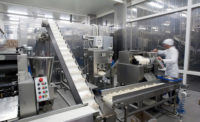Since its foundation, Tomoe Dairy Processing, Japan, has been delivering safe and secure milk and dairy products to schools, homes and workplaces under strict hygiene control. Freshness is essential to the chilled products Tomoe manufactures and sells. That’s why it initiated a variety of procedures to provide the original taste of high-quality raw milk. Ninety percent of products are shipped on the day the order is received. The infrastructure of Tomoe’s ICT system, which supports a short lead time and a stable supply line, is the Stratus ftServer from Stratus Technologies, Maynard, Mass.
Headquartered in Koga City, Ibaraki, Tomoe Dairy Processing Co. Ltd. provides milk products and beverages for elementary and junior high school lunches. Tomoe’s history begins in 1956, when former president Toshio Nakata took over at Kanto Chikusan Kogyo K.K. That company, which processed and sold milk as well as meat and ham, was in financial difficulties, and Nakata re-started it as a dairy farm. The city of Koga is located at the western edge of Ibaraki, and it was difficult to do business within the prefecture from that area.
“When we expanded our business area to the Kanto region, Koga was right in the middle,” says Toshiyuki Nakata, president and CEO. “In those days, it was difficult to sell to other prefectures (an administrative district of some countries, especially China or Japan). But, by building relationships based on the trinity of ‘production, processing and sales,’ we gained people’s trust and our business area expanded in all directions.”
These founding principles of “production, processing and sales” are also displayed in Tomoe’s logo. In 1962, the company changed its name to the present Tomoe Dairy Processing Co. Ltd. One of the pillars of the company’s management philosophy, “contributing to society through safe and secure milk and dairy products,” was formed out of the 3-way relationship between producers, processors and salespeople, and is represented in the mitsudomoe design (three comma-shaped figures in a circle) of the logo.
In response to increasing demand, Tomoe built a new factory equipped with state-of-the-art facilities in the current location in 1994. But, after it was completed, the company soon found that it was already too small, so it created plans to build a second factory.
However, those plans ended up going back to square one.
“We had been planning the second factory since 2005, but when the Great East Japan Earthquake happened in 2011, we again felt how important a ‘stable supply’ is, so we reviewed our plans from the beginning,” says Nakata.
This second factory, completed in 2013, features an uninterruptible power supply and incorporates a variety of measures to ensure a stable supply, including a substation on the premises and a solid warehouse system that will not collapse even in an earthquake.
Today, Tomoe Dairy Processing is said to operate the largest-scale processing factory for milk in Japan. However, a stable supply is not established just by strengthening the manufacturing facilities.
The information and communications technology (ICT) system manages the relationship between received orders and production. A review of the ICT system was needed for a stable supply of safe and secure milk and dairy products.
“Because we were fortunate in that no major problems occurred in our company’s ICT system, the implementation of availability measures had been put on the back burner,” says Kazuto Hiroki, system manager of the sales department. “Also, our online order management system, which is the most important thing in our business, was operating on a single server. We were living with the risk that, if the server had malfunctioned, that day’s operations—everything from production to shipping—would have been stopped.”
Because milk and dairy are chilled products for which freshness is essential, the lead time is extremely short.
“It’s not unusual for an order to be shipped on the same day it’s received. If the system stopped even for an hour during our peak shipping period, between noon and 3:00 p.m., we would incur large losses and it could be fatal to our business. So, when it was time to replace the hardware, we started to consider building a highly reliable infrastructure platform that wouldn’t stop even if there were a system malfunction,” adds Hiroki.
First, business does not stop even if there is a hardware malfunction. Second, the system keeps operating without human intervention when a malfunction occurs, and recovery is simple and requires no follow-up.
“Our factory operates 365 days a year, but we don’t have a full-time information systems department,” says Hiroki. “We thought that, in a setup where people would have to do switch-overs when a system malfunction occurred, we would not be able to ensure a stable supply even with redundancy.”
What Tomoe wanted was a server that achieved “unattended operation,” so that operations would not stop even if a malfunction occurred when operators weren’t present.
Stratus Technologies’ always-on solution, the ftServer, was suggested by Daiko Denshi Tsushin Ltd., the Japan-based company that has been providing support for Tomoe’s ICT system for over 20 years.
“We were using an active standby system as the infrastructure for our automated warehouse system. However, in the past, manual switching was required when a malfunction occurred, and we found that recovery operations were very hard. We considered a cluster system, but we lacked the know-how. It was also very expensive,” says Hiroki. “The ftServer has an exceedingly high stable operation rate and the occurrence of downtime itself can be prevented. It doesn’t need to stop running when maintenance is being performed and recovery operations are easy. Most of all, we can avoid impacting our business. The ftServer was the only one that matched our requirements.”
The ftServer’s hardware components are fully redundant, and the two CPUs are always synchronized, performing the same processing simultaneously. Thus, if one component malfunctions, the component mirroring it continues processing. In this situation, there is no system “switching,” and therefore no impact on the operating system or the applications running operations. From the time a hardware abnormality or malfunction is detected until full duplex operations are restarted by component replacement, the operations continue with the system remaining unaffected. Being familiar with Tomoe’s EDI system and the challenges of the entire system, including management structure, Daiko Denshi Tsushin suggested the ftServer as a system infrastructure that would support the stable supply required by Tomoe.
“The online ordering system is essential for our company’s business,” Hiroki says. “With our volume of transactions, when they stop, not only does business stop, but the trust relationship between ‘production, processing and sales’ is affected too. I can’t emphasize enough how important it is to ensure stable system operations for a stable supply of products. The most important place to start is the system infrastructure.”
At Tomoe, the first ftServer was initially installed on Intercom’s EDI solution “Biware” platform. But, there was a malfunction about six months after installation.
“The malfunction occurred after I had left the office, but we were able to continue operations without incident, and the following day maintenance support was carried out,” Hiroki says. “We felt that it would really be okay even if nobody was there.”
Tomoe then decided to use two ftServers as the platform for the company’s file servers.
“Tomoe’s production management data is stored on our company’s file servers. Daily production is performed according to this production management data. At peak production time, adjustments to production instructions are entered hourly, so we see our file server as a mission-critical system as well. That’s why, when it was time to replace our file servers, we decided to use the ftServer. There are still areas where we need to invest in IT, but we feel that we’ve made considerable progress toward reaching the stable supply we profess,” says Hiroki.
Having celebrated their 60th anniversary, Tomoe Dairy Processing is setting up their grand design for the next 10 years, with an eye to laying the foundation for 200 years.
”In 2015, we reached 34.5 billion JPY in annual sales. We want to reach 50 billion JPY in expanding sales into the Kansai region, we are going to expand our market into Asia, such as Myanmar and Vietnam,” says Nakata.
Besides expansion, Tomoe is also working on developing health-value-added products, building healthy brands and conducting research into milk to improve its added value.
The “Milk Museum,” located on the company’s premises since 1994, contains over 5,000 unique items related to dairy farming and the dairy industry. It is dubbed as the only museum of its kind in Japan, offering a close-up experience of the history and development of dairy products. Part of Tomoe’s management philosophy is “there is culture in industry,” and it is by handing down information about dairy culture that the company is actively striving to preserve and develop the local culture.
“Milk includes a good balance of nutrients that are essential for maintaining good health,” Nakata says. “Like the expression ‘ishoku dogen (nutrition and medicine are equally important for health),’ which is part of our management philosophy. As a doctor, I believe that, going forward, it is my duty to provide everyone with sources of health.”
From their beginnings as a Kanto dairy manufacturer and expanding their business area throughout Japan and into Asia, Tomoe Dairy Processing has pushed forward to improve the value of milk. They will not stop on their path toward a 200-year business.


